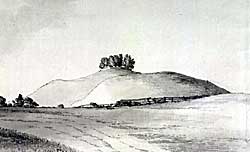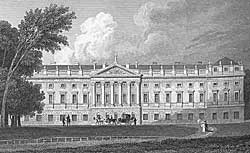Events in Spring 2004
Keyworth– host to this year's Annual General Meeting
Keyworth village has a population of around 7,000 and serves mainly as a commuter place for Nottingham, although the British Geological Survey is a significant employer. The village was mentioned in Domesday, but Roman and pre-Roman finds in 2001 suggested a much longer existence. Until the 19th century it was linear with farmhouses and cottages flanking a quarter-mile long street, now Main Street. At the northern end was the village church, manor farm, village cross, pump and pinfold; only the church remains. The windmill was demolished in the 1950s. A medieval barn remains on Main Street.
The early village had three open fields containing around 3,000 strips
plus a large common, which was enclosed by act of 1798. In the 1860s the
main source of employment was framework knitting, but only two workshops
now survive. Nonconformity came to the village reasonably early and the
original chapel can be seen at the end of Elm Avenue as part of a private
house. Part of the old village is a Conservation Area and there is
a nature Reserve on its southern edge.
Howard Fisher
OBITUARY - Byron Paul Barrett
Byron was born 78 years ago in West Bridgford, and passed away on Friday 12 December 2003. He was a man of many parts and interests. As a young boy he had stage dancing lessons, and his interest in the theatre brought him into contact with his future wife, with whom he had a daughter, Jane.
Byron was born into the family business of fabrics and carpet supply and fitting, which he followed as his career. The family moved into the city for a spell, then back to West Bridgford where he lived for the rest of his life.
From about 1955 he helped with the Nottingham Museum Society, which led to him becoming one of the founder members of the Friends of Nottingham Museums. This he continued with, taking many active roles within the Friends and helping with the summer outing arrangements. He also helped with the cave tours of Broadmarsh and the sand mine tours in Peel Street, and with Wollaton Hall tours.
Byron was a member of the Heraldic Society, Brass Rubbing Society, Nottingham
Civic Society, and gave magic lantern displays at Newstead Abbey, as well
as being a cinema projectionist. He had a great interest in clocks, and
his collection took up much of his home. He was a quiet, unassuming gentleman,
who will be greatly missed by the many Societies with which he was associated.
He was keeper of the Book Sales stock, which he brought to each monthly
meeting of the Thoroton Society.
Robert Creates
NOTTINGHAMSHIRE HISTORY ON THE WEB
 |
Annesley Castle in the late 18th century. |
Collect Britain: Putting History in Place – this is the British Library’s largest digitisation project to date. By Summer 2004 an impressive 100,000 images and sounds from the BL’s world-renowned collections should be available on line. Two collections which might be of interest to members are The Notebooks of Samuel Hieronymus Grimm (covering the period 1773-1794) – this includes 2,500 drawings Grimm made for Sir Richard Kaye, who eventually became Dean of Lincoln; and Early Ordnance Survey Maps of Nottinghamshire – including interactive images of maps for the Newark area, Nottingham and south west Nottinghamshire and the Trent valley north of Newark. Check out www.collectbritain.co.uk.
 |
Worksop Manor in the 1820s. |
Jones’ View of the Seats, Mansions, Castles, &c (1829) - Wonderfully detailed images of some of Nottinghamshire’s county houses as they appeared in the early 19th century come from this publication, described as ‘a sort of 19th century “Doomsday Book” of many of the fine stateley homes in the British Isles’. The illustration shows the second Worksop Manor, designed by James Paine to replace the Elizabethan mansion burned down in 1761. Only one wing was completed and it was demolished in the 1840s. See www.antiquemapsandprints.com/geography-travels/BOOK-JONES-SEAT.
Nottinghamshire and Domesday Book - David Roffe, a respected scholar whose research interests include the Danelaw, landscape history, church history, and insanity in the Middle Ages, includes on www.roffe.freeserve.co.uk papers on pre-Conquest Nottingham and on the Nottinghamshire Domesday.
Historical Directories Project, Leicester University - Leicester University is currently running a project to establish a digital library of 18th, 19th and early 20th century local and trade directories from England and Wales. Directories of counties and towns are among the most important sources for local and genealogical studies. Nottinghamshire trade directories already on line include White’s county directories for 1832 and 1885-86, and Wright’s directory of Nottingham, 1905. Check out www.historicaldirectories.org.
Nottinghamshire History and Archaeology - The Nottinghamshire
History and Archaeology site contains numerous texts on a wide variety
of subjects, from an article on the Fight at Willoughby Field during the
English Civil War, to a guided tour through the late Victorian streets
of Nottingham courtesy of Allen’s Illustrated Guide to the town.
Other resources include complete online versions of Cornelius Brown’s
History of Nottinghamshire, White’s History of Worksop, and a diverse
collection of articles drawn from early Transactions of the Thoroton Society.
See www.nottshistory.org.uk.
Andy Nicholson
Members of the Thoroton Society: The New England Historic Genealogical Society
Many prestigious organisations and institutions at home and overseas are
members of the Thoroton Society: here are some notes about one of them.
The New England Historic Genealogical Society was founded in 1845-52 years
before the Thoroton Society. It started because of an increasing interest
amongst the inhabitants of New England in tracing their ancestry back to
the first settlers. In 1964 it moved into its present home in the prestigious
Back Bay District of Boston. Its five storey building houses one of the
finest genealogical libraries in the country and many other records of
interest to researchers-many of which can be consulted on line. It
has 20,000 members and in 2000 lent out 23,000 books. See their website
at www.nehgs.org for further details and to take
a virtual tour of their building.
Keith Goodman
WOLLATON VILLAGE DOVECOTE MUSEUM
The new season at Wollaton Village Dovecote Museum – which enjoyed record attendances last year – opens on Sunday 9 May, and will continue on 13 June, 11 July and 8 August, as well as Heritage Weekend on Saturday and Sunday, 11 and 12 September. Some Saturdays might also be included.
For the first time the museum will levy a modest charge of 50p for adults.
A vast collection of school photographs, some not yet seen, will be on
show – but the highlight will be an exhibition in June marking the
60th anniversary of the D-Day landings. Anyone who can help with exhibits
for the D-Day displays, please contact the curator Mrs Maureen Jones on
0115 9282567. Mrs Jones can also arrange group visits to the four centuries
old listed building.
Emrys Bryson
THE EAST MIDLANDS COLLECTION, UNIVERSITY OF NOTTINGHAM
Thoroton Society members can borrow books from the East Midlands Collection
(Hallward Library, University of Nottingham) if they wish:; to do so they
need a card from the main counter on Level 2, and will require a passport
type photo, plus proof of membership of the Society, plus proof of name
and address. Those members with Internet acces can consult the catalogue
online, which is on the following website: (http://aleph.nottingham.ac.uk/ALEPH),
although not all EMC is catalogued online yet - much remains on the old
card catalogue. Members are also very welcome to use the manuscript collections
(as are all members of the public) and for this would additionally need
to register with the library (which needs proof of name and address). Descriptions
of collections are on the website (http://mss.library.nottingham.ac.uk/),
as are detailed catalogues of some of the collections.
Corinne Fawcett